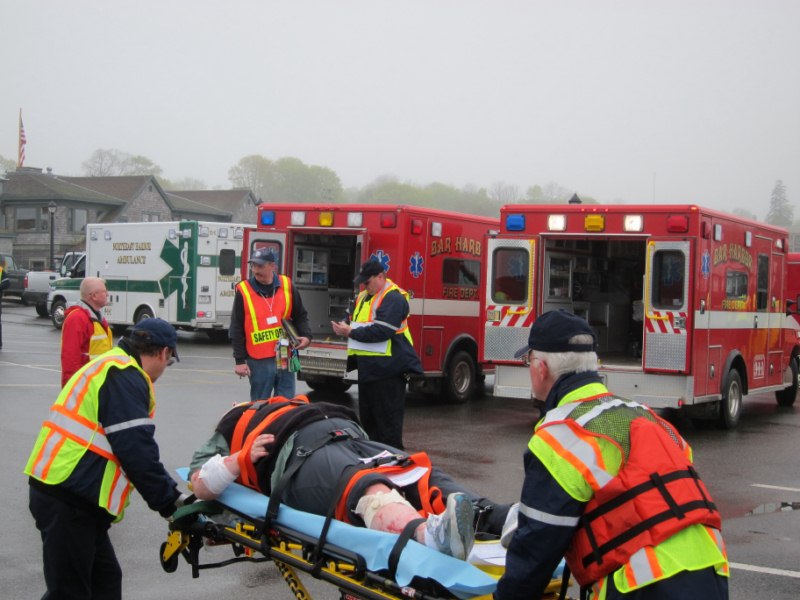 The United States Coast Guard, along with Royal Caribbean Cruises, and local, state and federal agencies, including the American Red Cross, successfully completed a Mass Casualty Incident Drill (MCI) in Bar Harbor, Maine, on May 18.
The United States Coast Guard, along with Royal Caribbean Cruises, and local, state and federal agencies, including the American Red Cross, successfully completed a Mass Casualty Incident Drill (MCI) in Bar Harbor, Maine, on May 18.
Some 300 people participated, including a large number of local volunteers who willingly played victims.
“The cruise industry in Maine is a growing industry and we all have a responsibility to make sure we have plans in place, and that we know our partners and our partners know us,” commented Captain Jim McPherson, commander of Coast Guard Sector New England.
The drill (without a cruise ship presence) simulated two cruise-ship tenders making contact on a foggy morning in Bar Harbor. The port will have seven days this season with three ships in town, and undoubtedly a high amount of tender traffic.
“We get everyone together in a realistic scenario to practice what could happen and see how all these agencies work together,” said Rear Admiral Daniel A. Neptun, commander, United States Coast Guard.
“It’s about good communication and making it safer for groups to come here on ships, making sure the community is ready if something ever happened.”
 With limited emergency response infrastructure in a rather rural area, the drill was designed to deal with triage, communication issues, agency cooperation, and patient care and transportation.
With limited emergency response infrastructure in a rather rural area, the drill was designed to deal with triage, communication issues, agency cooperation, and patient care and transportation.
Added Rob McAleer, director of the Maine Emergency Management Agency: “We are building up relationships between agencies. The bonding after two years of planning is taking place, and agencies know how to work together.”
Following a call for help at 10:00 am, local emergency responders rolled, along with the response of good Samaritans in local fishing boats, pleasure crafts and sightseeing vessels.
Eight minutes later emergency responders learned that there were 29 injuries, and at that point made a decision to ask for additional help from the greater area. Ambulances staged on the town’s pier while the fire department set up its incident command post.
As various boats brought patients to shore, EMTs has to assess the level of care needed (triage), separating them into various groups and transporting as necessary.
 Neptun told Cruise Industry News that hospital staff came in on their day off to help with the drill. The local hospital was able to handle the surge of drill patients, even while running its own emergency room with seven patients.
Neptun told Cruise Industry News that hospital staff came in on their day off to help with the drill. The local hospital was able to handle the surge of drill patients, even while running its own emergency room with seven patients.
Additionally, despite radio traffic on Maine’s emergency frequencies saying it was a drill, a whale watching vessel actually responded to the incident location, “that shows the maritime community’s Samaritan spirit,” added Neptun. “They will help out anyone in distress.”
Incident commanders had to determine care levels and put multiple patients in each ambulance, as well as deal with more patients being brought to the pier, sometimes in need of urgent attention.
Over a few hours, patients were brought in on a simulated schedule, at times trying to overwhelm the shore-side response team.
That team, which included the local fire department and various ambulance companies, also had to work on their feet, and at times were left with limited equipment with all the ambulances available on “hospital transports” and on their way back to the incident.
Officials also noted that in some cases the hospital actually re-classified some patients as more injured than their original assessments by first responders on the pier.
EMS personnel worked on a patient, stabilizing them, and then moved onto the next patient that needed the most urgent attention.
 Assets were brought in from surrounding areas, such as more ambulances, additional personnel and lifting assistance, with realistic response times.
Assets were brought in from surrounding areas, such as more ambulances, additional personnel and lifting assistance, with realistic response times.
“Accountability is the big thing here,” commented Richard Pruitt, associate vp of environmental programs at Royal Caribbean Cruises. “We always want to cooperate with the Coast Guard. Obviously we want to see how our guests would be accounted for.”
Pruitt added that the drill had been under design for more than a year, and that the cruise line went as far as making sure some of the “victims” did not have SeaPass cards on them to see how the response team would cope.
During the drill, Royal Caribbean’s situation room in Miami was “stood up,” helping the on-site team, which consisted of about 15 people, including Steve Williams, director of medical operations.
During a real emergency, Pruitt pointed out, the cruise line would be responsible for arranging flights, hotels for family and more. He also noted an issue figuring out which passengers were on tenders headed back to the ship, since they don’t swipe in until they get onboard.
“We know who isn’t on the ship, but we don’t know (yet) who is on the tender going back to the ship,” he commented.
Read a full, exclusive report of the MCI drill in Bar Harbor in the summer edition of the Cruise Industry News Quarterly Magazine, out July 1.



